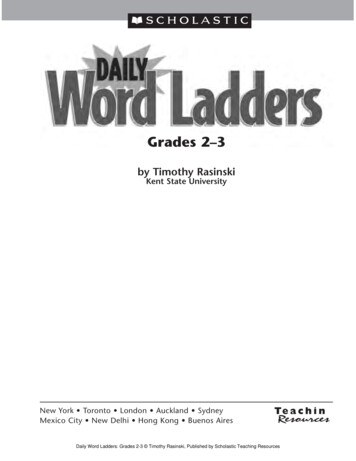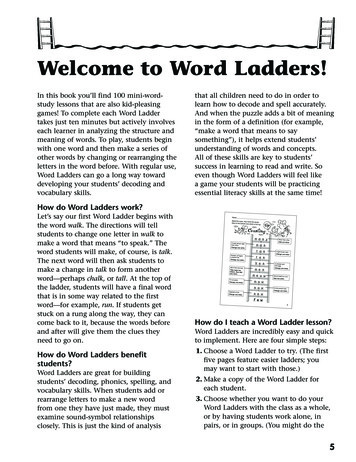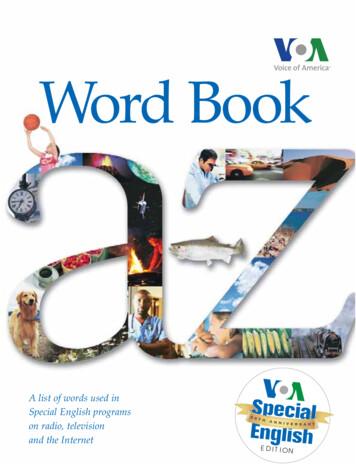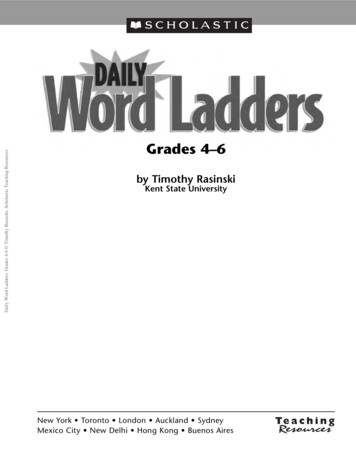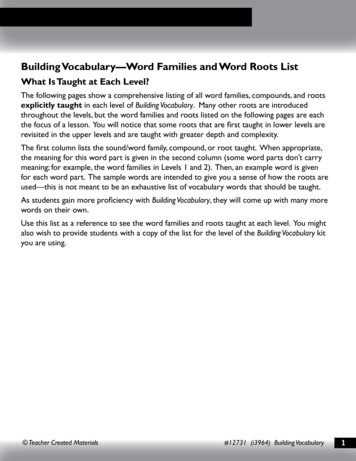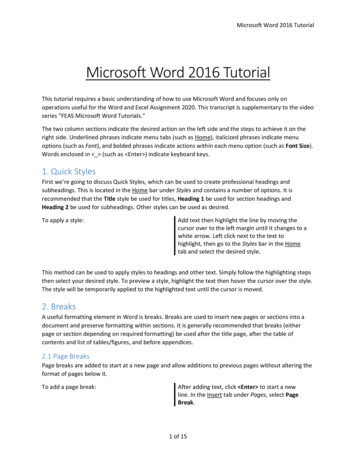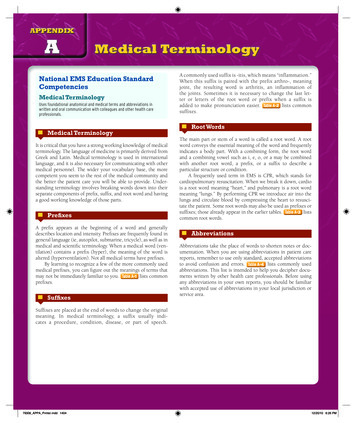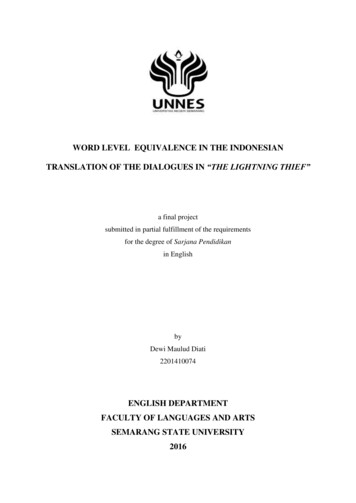
Transcription
WORD LEVEL EQUIVALENCE IN THE INDONESIANTRANSLATION OF THE DIALOGUES IN “THE LIGHTNING THIEF”a final projectsubmitted in partial fulfillment of the requirementsfor the degree of Sarjana Pendidikanin EnglishbyDewi Maulud Diati2201410074ENGLISH DEPARTMENTFACULTY OF LANGUAGES AND ARTSSEMARANG STATE UNIVERSITY2016
ii
iii
MOTTO AND DEDICATION―When you have never made a mistake, it means you have not tried anything.‖(Dewi Maulud D)To:My beloved parentsBrothers and sisteriv
ACKNOWLEDGEMENTSAlhamdulillahirrabilalamin, first and foremost I would like to thank Allah SWT forall the blessings, chances and directions in every step in doing this final project.I would like to express my sincerest gratitude to the Dean of Languages and ArtsFaculty, the Head of the English Department, the Head of English Education sub-department,and the entire staff and librarian of English Department for the lessons, knowledge, andexperiences during my many years of education.I would like to express my greatest gratitude to Dr. Issy Yuliasri, M.Pd. as my advisorfor all of the suggestion, advice and chance for the process of finishing my final project.Next, the the deepest gratitude also devoted to English Department lecturers IkhwanRosyidi, M.Hum., Arif Suryo Priyatmojo, S.Pd, M.Pd., and Alief Noor S.Pd, M.Pd. who hadthe kindness to be a rater of word level equivalence meaning in this study.Then, I would like also to express my special thanks to my family, my motherMudrika for being the most persistent and hard-willing person that motivates me, my father,brothers and sister who always support me when I was down and unmotivated. I would alsolike to express my gratitude to Muhamad Rafi Aziz for all supports and helps that youprovide.And for the last but not the least, I would like to thanks my lovely friends, Fita, Aulia,Ayu, Ulfa, Anis, Sinta, Tami, and Awal for being good friends for the years we had and timewe spent. The deepest gratitude is also addressed to all the researcher‘s friends of EnglishEducation 2010.Semarang, January 2016Dewi Maulud Diativ
ABSTRACTDiati, Dewi Maulud. 2016. Word Level Equivalence in the Indonesian Translation ofDialogues in Rick Riordan’s “The Lightning Thief”. A final project.English Department. Languages and Arts Faculty. Semarang StateUniversity. Advisor: Dr. Issy Yuliasri, M. Pd.Keywords: Word level equivalence, Dialogues, Utterances, The Lightning ThiefThis descriptive qualitative study mainly describes the word level equivalence foundin the translated dialogues in The Lightning Thief. This topic is chosen since word levelequivalent has a prime rules in rendering the meaning across languages and cause someproblems in finding a correspondence in target language. This condition may lead to theoccurance of word level non-equivalence. That is why there must be strategies used bytranslators to overcome the problems. Thus, the objective of this study were to identify theword level equivalence strategy in the translated dialogues in The Lightning Thief and toidentify its word level equivalence meaning.The final project mainly aims at identifying the word level equivalence strategy intranslating the dialogues of The Lightning Thief from English into Indonesian and identifyingits word level equivalence meaning. The study focuses on the classification of word levelequivalence offered by Mona Baker in her book In Other Words. The data obtained wereanalyzed by comparing both English and Indonesian versions. Words or phrases whichcontained any word level non-equivalence were analyzed further to find out the context inwhich it occured. Then the data analyzed were evaluated its word level equivalent meaning.The evaluation involved some raters who are expert in their field.The finding shows that: the strategies used by the translator to overcome the problemsin translating the dialogue are translation by paraphrase using related word (24.11%),translation by a more specific word (18.43%), translation by paraphrase using unrelated word(14.89%), translation by a more general word (14.19%), translation by omission(13.48%),translation by more expressive or less neutral word (8.51%) and translation byusing loan word or loan word plus explanation (6.39%). Word level equivalence meaning inthe strategies: translation by using loan word (92.59%) was the strategy whose data were gothigher result of score 3 (meaning is sufficiently renderred) by three raters, translation by amore general word (36.67%) was the strategy whose data were got higher result of score 2(meaning is insufficiently), and translation by omission was the strategy whose data were gothigher result of score 1 (59.65%).Suggestion drawn from this study is that to transfer meaning of the source text intothe target text accurately, the translator should decide to make choices in each word orphrases, and choose the most suitable strategies that can overcome problems and difficultiesof translation, especially problems of non-equivalence at word level.vi
TABLE OF CONTENTSACKNOWLEDGEMENTS .vABSTRACT . viTABLE OF CONTENTS . viiCHAPTERI. INTRODUCTION .11.1 Background of the Study .11.2 Reasons for Choosing the Topic .21.3 Statement of the Problems .31.4 Objectives of the Study .31.5 The Significance of the Study .41.6 Outline of the Final Project .4II. REVIEW OF RELATED LITERATURE .52.1 Review of the Previous Studies .52.2 Review of Theoretical Study .82.2.1 Definitions of Translation .82.2.2 Types of Translation .102.2.3 Equivalence in Translation .122.2.3.1 Definitions of Equivalence .122.2.3.2 Problems of Non-Equivalence at Word Level .12vii
2.2.3.3 Strategies in Non-Equivalence Problems of Translation .152.3 Theoretical Framework .17viii
viiiIII. RESEARCH METHODOLOGIES .193.1 Research Design.193.2 Object of the Study .203.3 Type of Data .203.4 Role of Researcher .203.5 Procedure of Data Collection .213.6 Procedure of Data Analysis .21VI. FINDINGS AND DISCUSSION .224.1 Findings.224.1.1 Strategies for Word Level Equivalence .224.1.2 Word Level Equivalence in the Translated Dialogues .244.2 Discussion .264.2.1 Translation by Paraphrase Using Related Word .264.2.2 Translation by a More Specific Word .284.2.3. Translation by Paraphrase Using Unrelated Word .294.2.4 Translation by a More General Word .304.2.5 Translation by Omission .314.2.6 Translation by Less Neutral/More Expressive Word.324.2.7 Translation Using a Loan Word or Loan Word Plus Explanation .33V. CONCLUSIONS AND SUGGESTIONS .355.1 Conclusions .355.2 Suggestions .36
ixREFERENCES .37APPENDIX .39
CHAPTER IINTRODUCTIONThis chapter presents the background of the study, the reasons for choosing the topic,the statement of the problems, the objectives of the study, the significance of the study, andthe outline of the final project.1.1 Background of the StudyReading is one of interesting activity for some people, indeed some of them assume thatreading is a need and hobby. Many kinds of reading we can find in our daily life throughseveral media, such as news paper, magazine, television, internet, and the book itself. Peopleread something to get information. For some people who has a hobby of reading, they willread something because they are interested in reading.From various kind of reading, novel is one of the media of reading which has fascinationfor some people. Novel is a long prose narrative that is normally in prose, which describesfrictional characters and events, usually in the form of a sequential story. Many of story innovel have been filmed and watched by people. Besides the plot of the story or the content ofthe story, one of the interesting thing is the dialogue in the novel. Some of best popular novelare originally available in English, and to adapt it, the novel were translated into differentlanguages, such as Bahasa Indonesia.Translating the novel especially the dialogue of the novel from source language (English)into the target language (Indonesian) is not an easy task. The translator must consider notonly the word selection but also the message delivery. In this point, a question come up: doesthe target language (Indonesian) novel, especially dialogues of the novel, deliver the samemessage as the source language (English) dialogue of the novel? Therefore, it is interesting1
2to find out whether the target language dialogues of the novel have delivered the samemessage as the source language dialogues of the novel or not. Ultimately, the messagetransfers from source language to target language can be accomplished by several strategiesand making sure of the word level equivalence between the two languages. From this reason,I conducted the research of translation equivalence in the dialogues of the novel entitled “TheLightning Thief” particularly in terms of word level equivalence. In this research, I use wordlevel equivalence classification by Baker (1992).1.2 Reasons for Choosing the TopicPeople often spare their time to read something. Whatever reading that they read,people have different taste. Novel is one of the most interesting media that everyone can read.Besides the plot of the story or the content of the story, one of the interesting thing is thedialogue in the novel. In many novels, we can find and read some dialogues that describe thecharacters of the actor in the story. Dialogue also describes the attitude and habit of theactors in the story. The creativity of the writer in making dialogue makes the readersinteresting in reading novel.Many of interesting novel are written in English, and due to the Indonesian, English –Indonesian is needed. In the process of translating from English into Indonesian, thetranslators might find some problems such as no equivalence at word level, and there couldbe some strategies used by the translators to overcome such problems. Therefore, my reasonsfor choosing the topic ―Word level equivalence in dialogue ―The Lightning Thief‖ are statedas follows:1) Dialogue is one of the interesting thing in novel. Content of the story is the reason whypeople interested in reading a novel. In the content of the story, writer often adds some
3dialogues to entertain the readers. The dialogues describe some actor‘s character, attitude,and habit. Not rarely, the writer creates an intersting dialogue to describe the actors in thestory.2) Baker states that there is no precise word to word equivalence across languages and thismay pose some problems in terms of finding a direct correspondence in the targetlanguage (TL). Some strategies are used in translating the dialogues when there is noequivalence at word level. According to Baker, word level equivalence may differ fromone product to another.1.3 Statement of the ProblemsIn this study, the writer limits the discussion by presenting the following problems. Theproblems are:1. What are the strategies used by the translator in translating the dialogues in the novelentitled The Lightning Thief?2. How is the word level equivalence meaning in the translated dialogues in TheLightning Thief?1.4 Objectives of the StudyThe objective of this study are:1. Identify the strategies used by the translators in translating the dialogues in the novelentitled The Lightning Thief based on Baker‘s classification of word level equivalence2. Find out the word level equivalence meaning in translated dialogues in The LightningThief.
41.5 Significance of the Study1) The results of the study are expected to inform the readers, the writers, and the translatorsthat the word level equivalence is important for rendering the message of dialogues fromthe source language (English) to the target language (Indonesian).2) The result of the study is expected to be a reference on how important the word levelequivalence is and how it influences the message transfer from the source language to thetarget language in the translation process.1.6 Outline of the final projectThe final Project consists of five chapters as follows:Chapter I is the introduction, which has several sub-chapters consisting of: thebackground of the study, reason for choosing the topic, statement of problem, objective of thestudy, and significance of the study.Chapter II is review of related literature, which presents a review of the previousstudies and review of theoretical study. The review of theoretical study provides theories thatsupport this study. There are definitions of translation, types of translation, equivalence intranslation, and definitions of dialogue.Chapter III is the method of investigation. Which contains research design, object ofthe study, type of data, role of reseracher, procedures of data collection, and procedures ofdata analysis.Chapter IV is the findings and discussion, which consists of findings, and discussion.Chapter V presents the conclusions and suggestions.
CHAPTER IIREVIEW OF THE RELATED LITERATUREThis chapter provides the review of the previous studies, review of theoretical study andtheoretical framework.2.1 Review of the Previous StudyThere have been a number of studies related to translation, but there were few studiesdone on dialogue translation, especially at word level equivalence. Among the studies onword level equivalence, each of them were found in the English Department Library ofSemarang State University:The first study is ―Word Level Equivalence of Indonesian-English Translation ofAbbreviation Found in the Jakarta Post‖ by Munir (2009). This study mainly aimed at findingthe strategies used by the transltaor in translating the abbreviataion found in the Jakarta Postduring January – May 2007. There were 103 abbreviations as sample data from Indonesianinto English. The study used word level equivalence classification of Baker (1992) and it wasvonducted under the consideration offered in her book In Other Words: a course Book onTranslation (1992) that in translating source text (in this case indonesian) to target language(English) we can use some strategies to get the closest equivalent words to achieve thenatural and acceptable translation. The findings of the study showed the following strategies:translation by more general word (superordinate) (12,62%), translation by more neutral/lessexpressive word (24,27%), translation using loan word or loan word plus explanation(3,88%), translation by paraphrase using related words (8,74%), translation by omission(11,66%), translation by more specific word (subordinate) (24,27%), some accuratetranslation (the closest equivalence) (14,56%).5
6There are some suggestions that were drawn from this study: to produce a good andnatural translation, translators should constantly make choices in each word, sentences ortranslation unit so as decide the most suitable strategies that can overcome the problems anddifficulties of translation, especially problems of non equivalence at word level.The second study is ―Word, Above Word and Grammatical Equivalence in theTranslation of J.K. Rowling‘s Novel entitled “Harry Potter and the Goblet of Fire” byKustanti (2006). The objective of this study was to identify the word, above word andgrammatical equivalence in the novel “Harry Potter and the Goblet of Fire” written by JoaneKathleen Rowling and translated into Indonesian as “Harry Potter dan Piala Emas” byListiana Srisanti and to see what strategies were used to make the translation equal. Thefindings of the analyses are as follows: Some strategies found to achieve word-levelequivalence were: more general word, more specific, more neutral, more expressive, culturalsubtitution, loan word, omission, and addition. With regard to non equivalence above wordlevel, the equivalnce can be achieved by various types of strategies: similar meaning andform, similar meaning and dissimilar form, paraphrase, omission, and addition. Theequivalence at grammatical level can be achieved by various strategies too: with regard tonumber, the equivalence can be achieved by maintaining the SL plural form into the TLplural form; by changing the SL plural form into TL singular form for some nouns whichalways take plural forms as they refer to pair or two things. The gender aspect is absent inIndonesian both in the third person singular and its pronoun. With regard to person, theequivalence can be achieved by involving the inclusive/exclusive dimension and thefamiliar/non familiar dimension from the SL into the TL. The distinction of temporaldistribution in Indonesian was expressed in a certain word, and the last, changing the voicefrom SL active into TL passive is more natural.
7Kustanti suggested that the translator should be careful when translating bothindividual words or collocation and idiom since they carry meaning and the meaning can beculture-specific. For this reason, the translator should understand various problems intranslation in each level, so that she can choose the nearest word and sentence in the taegetlanguage.Another study was ―The Strategies Dealing with Problems of Non-Equivalence atWord Level Found in the Translation of Stephanie Meyer‘s Novel Entitled “Twilight” byFitriyani (2010). The aim of the study was to identify and classify the strategies used bytranslator, dealing with the non-equivalence problems at word level which occired in thetranslation of a novel by Stephanie Meyer‘s entitled “Twilight”.There were some conclusions given by Fitriyani (2010). The first conclusion was thatalmost all of the strategies suggested by Beker (1992) were used in the translation ofTwilight. It was suggested that the translator has to know the strategies to overcome theproblems of non-equivalence, so the messages from the source language can be transferredproportionally and appropriately into the target language. He or she also has to know that oneword may not carry only one meaning and adjust the word in the target language with thecontext and culture in order to facilitate the reader to get information from the text.Last study was ―Word Level Equivalence in Advertising Headlines Translation‖ byLuluk Efendi (2012). The aim of the study was to identify the strategies used by thetranslators in translating the advertising headlines based on Baker‘s classification of wordlevel equivalence.The study revealed that there were seven strategies used to translate advertisingheadlines: translation by paraphrase using unrelated words (39,53%), translation byparaphrase using a realated word (22,09%), translation by omission (15,12%), translation by
8a more specific word (10,46%), translation by a more general word (6,97%), translation by aneutral word (4,65%), and translation by using a loan word (1,16%).There were some suggestion that were drawn from this study: the translator shouldadjust the word in the target language with the context and culture in order to make thetranslation result natural and acceptable since on e word may not carry only one meaning.Most of the studies above were about equivalence and strategies in translation andnone of them which identify dialogue dealing with word level equivalence. Considering thatthere was still an area that had not been explored, I decided to analyze the translation ofdialogue in Rick Riordan‘s novel.2.2 Review of the Theoretical StudyIn this section, I would like to review the theoretical studies relevant to the topic ofthe study. They are definitions of translation, types of translation, equivalence in translation,and definitions of dialogue.2.2.1 Definitions of TranslationTranslation has various definitions which can be a broad or narrow one. The broaddefinition of translation is a change from one form to another, for exampletransforming afeeling into a poem or lyrics.It is also revealed by Larson (1984:3) that translation consist of transferring meaningof Source Language into the Receptor Language. It means that the act of translation involvesthe change of form from the first language to the form of the second language; but themeaning is still constant. The form from which the translation is made will be called SourceLanguage (SL) and the form into it is to be changed will be called the Receptor Language orTarget Language (TL).Translation contains a large number of values such as, culture, language, and so on.Further, translation has a large of experts who reveal, research, and define all it one. Catford
9(1965:1) explains that, ‗Translation is the replacement of textual material in one language(SL) by equivalent textual in another language (TL)‖. Next, Nida (1969:12) defines that,translation consists in reproducing in the receptor language the closest natural equivalent ofthe source-language message, first in terms of meaning and secondly in terms of style‖.According to Newmark (1988:7), on the other hand, ―Translation is a craft consisting in theattempt to replace a written message and/or statement in one language by the same messageand/or statement in another language‖. It is also revealed by Bell (1991:1) that, ‗Translationis an art or craft and therefore not amenable to objective, scientific description, ex[lanation.As quoted by Hewson and Martin (1991:38) Steiner states that, ―The role of the ranslation isdetermining in this process cultural cross-determination, since in translating the dialectic ofunison and plurality is dramatically at work.From those definitions I can conclude that: (a) translation involves two languages, thesource language (SL) and the target or recptor language (TL); (b) to translate means toreproduce or to replace the message of the SL text into that of the TL text; (c) every translatormust find the equivalent of the TL; (d) translation is an art process of replacing the SL intoanother language (TL), involving cultural values.In translating, translator must definitely master both the source and the targetlanguage. As explained in the earlier chapter, each language has its own genius.Consequently, the translator should reproduce or replace the message by finding theequivalence of the SL so that the result is just what is intended by the author. In doing so, thetranslator should keep the essence of what is conveyed. As Machali (1998:1) comments,―translating is an art of recreating meaning, not that of creating meaning‖.From the definition above, we can conclude that translation transfers the message andchanges a form and translation is about communication.
102.2.2 Types of TranslationCatford (1965:21-26) divides translation based on three criteria: the extent oftranslation (full translation vs. Partial translation), the levels of language involved intranslation (total translation vs. Restricted translation), and the grammatical rankat which thetranslation equivalence is established (rank-bounded translation vs. Unbounded translation).In a full translation, every part of the source language text is replaced by the targetlanguage text material, whereas in a partial translation, some part of parts of the sourcelanguage text are, left untranslated (Catford:1965).In a total translation, the grammar, lexis, phonology or graphology of the SL arereplaced by their equivalence in the TL. In contrast, a restricted translation only replaceslimited textual materials of the SL with its equivalence in the TL, e.g. grammar and lexis(Catford:1965).Rank-bounded translation is normal total translation in which the selection of thetarget language equivalence is bounded or limited to a low rank or only a few ranks in thehierarchy of grammatical units, e.g. words or morphemes. In contrast, unbounded translationis normal total translation in which equivalence shift-freely up and down the rank scale(Catford:1965).The experts of translation mention the types of translation differently based on somepoints of view. Generally, it is divided into literal translation and non-literal translation.Larson as quoted by Simatupang (1999:6) divides the kinds of translation into two categories.One is meaning – based translation and yhe other is form – based translation. Form – basedtranslation attempts to folloe the form of the source language and is known as literaltranslation. On the other hand, meaning - based translation is translation that emphasizes onmeaning.
11Nida and Taber as cited by Simatupang (1999) support this type of translation bydividing translation into literal translation and dynamic translation. Basically, dynamictranslation has the same characters with the meaning – based translation, taht is emphasis onthe meaning rather than on the form.Litearal translation is translation that emphasizes on the form. For example, ‗Youmust study alone here‘ ‗Anda harus belajar sendirian disini‘. In the example, we can see thatEnglish and Indonesian are related, which means that the general grammatical form maysimilar, so the literal translation can be understood. However, in some cases, we can find thatliteral translation will produce an unnatural, because the Indonesian language uses differentexpression.Meaning – based translation (Larson: 1984) or dynamic translation is translation thatemphasizes on the meaning rather than form. For example:EnglishIndonesianGreen leafDaun hijauBe my guestSilahkanThe rivers runsAir sungai mengalirFirst phrase, ‗green leaf‘. Is not too difficult to be translated into Indonesian. It can beexpressed in Indonesian as ‗daun hijau‘, ‗daun yang berwarna hijau‘, or ‗daun itu warnanyahijau‘. The translation presents the real meaning of the source language and also presents thereal meaning of the sorce language and also presents the acceptable form of the targetlanguage.The sentence ‗be my guest‘, on the second example, is translated into Indonesian as―silahkan‖, not ‗jadilah tamu saya‘. The meaning of the third example, ‗the river runs‘, is ‗airsungai mengalir‘. The word ―runs‖ is expressed in Indonesian as ‗mengalir‘. Not ‗berlari.
122.2.3 Equivalence in TranslationIn this sub-section, we will discuss about the definition of equivalence by some professionalsand experts.2.2.3.1 Definitions of EquivalenceCatford (1965:21) notes that ―the central problem of translation practice is that findingTL translation equivalence. A central task of translation theory is taht of defining the natureand condition of translation equivalence‖. Equivalence is the most appropriate meaning ofsource language in the target langauge. Bell (1991:70) defines the term equivalence as thereplacement of stretch of a source langauge (particularly idioms, cliches, provrb, greetings,etc,) and the like by its functional equivalent.Baker (1992) acknowledges that equivalence can usually be obtained to some extent,but it is influenced by variety of linguistics and cultural factors and is therefore alwaysrelative. She outlines five types of translation equivalence; they are equivalence at wordlevel, equivalence above word level, grammatical equivalence, textual equivalence andpragmatic equivalence.2.2.3.2 Problems of Non-Equivalence at Word LevelBased on types of lexical meaning above, there are some of the more common typesof non-equivalence which often pose difficulties for the translator. Non0equivalence at wordlevel means that the target language has no direct equivalent for a word which occurs in thesourrcea) Culture-specific conceptIn culture specific concepts, the problems emerges as a result of source-language thatexpresses a concept of word which is totally unknown in t
entitled The Lightning Thief based on Baker‘s classification of word level equivalence 2. Find out the word level equivalence meaning in translated dialogues in The Lightning Thief. 4 1.5 Significance of the Study 1) The results of the study are expecte

